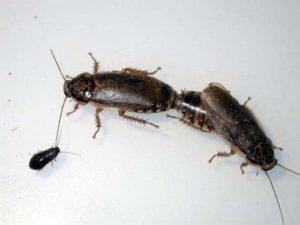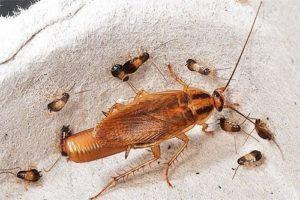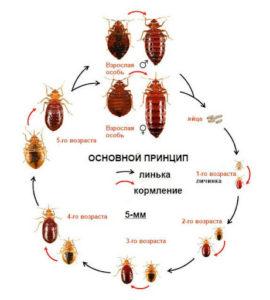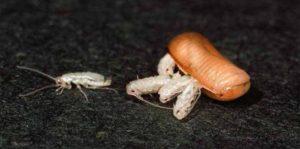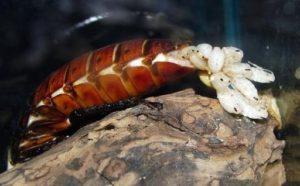How a cockroach gives birth: the life cycle of pests
People encounter cockroaches very often and many know firsthand exactly how they look. If at least one representative of this family was found in the apartment, then after a few months the number of insects can grow tens or even hundreds of times. Such rapid population growth is common for cockroaches, because many other animals can envy their vitality and fertility.
Content
The mating season for cockroaches
As you know, in most insects, the mating season begins with the advent of spring and lasts until about mid-autumn. This is directly related to weather conditions and the seasonal activity of different species. But, due to the fact that cockroaches settled next to a person, they ceased to depend on the change of seasons.
These pests are active throughout the year and their mating period, respectively, can last all 365 days.
How does mating happen?
Cockroaches, like other insects, reproduce sexually. The first mating occurs immediately after the female reaches sexual maturity. Feeling ready, she begins to produce special pheromones that attract males, and then instincts come into play.
Males of some species of cockroaches approach the issue of mating games very responsibly. They can take care of the female they like for some time before mating, and the “cavaliers” who claim the same “lady” sometimes even fight among themselves.
What happens after mating
After the mating process of the cockroach pair is completed, each of them goes about their business. Males leave in search of a new "lady" and food, and fertilized females lay eggs and take care of future offspring. One mating is usually enough for the female to be able to produce several fertilized ovipositions, without further participation of males.
During her whole life, one female cockroach can lay from 4 to 10 ovipositions. In different species, the number of eggs in one oviposition can vary from 10 to 60 pieces. Ultimately, in her entire life, the “cockroach mother” can give the world up to 600 new pests.
Females of certain species have even managed to adapt to the complete absence of males and have learned to fertilize eggs without mating.
Development cycle of cockroaches
The transformation of cockroaches from eggs into adults is characterized by an incomplete development cycle and includes the following stages:
- egg;
- nymph;
- imago.
Egg
The eggs of the female cockroach are well protected from danger. First of all, after fertilization, they are deposited inside a special chamber, which is called the ootheca. Such protective containers have sufficiently dense walls and protect eggs not only from mechanical damage, but also from temperature fluctuations.
The process of egg development until the larvae emerge can take from several weeks to several months. It depends not only on the type of insects, but also on the environmental conditions. In heat, embryos develop very quickly, but if the ootheca is in a room where the air temperature is below +15 degrees, then the process of their maturation may be delayed.
Females of some species carry their eggs on their body until the larvae emerge from them. For example, in the Prussians, the ootheca is attached to the underside of the female's abdomen and remains there until the young cockroaches hatch. At the same time, in other cockroaches, "bags" of eggs are separated from the mother's body and stored in a secluded place.
Nymph
Newborn larvae are born almost completely adapted to independent life.
Since there is no pupal stage in the development of cockroaches, miniature insects immediately emerge from the eggs, which differ from adults only in size and color intensity. In the first weeks after the birth of the larvae, the females of some species take care of them and help in the search for food.
In most species, newly born nymphs have white or transparent integuments. In the process of development, they increase in size and molt several times. The period of transformation of the larva into an adult cockroach largely depends on external conditions. At air temperatures above +20 degrees Celsius, this stage can last from 3 to 6 weeks. In a cooler room, the nymphs will develop several times longer.
Imago
All the way from an egg to an adult insect, in different species, can take an average of 3 to 6 months. Since the structure of the bodies of larvae and adults of cockroaches practically does not differ, their main difference is puberty. As soon as the nymphs mature and become ready for mating females and males, they can safely be called adults. Life expectancy at the adult stage can range from several months to several years, depending on the variety and living conditions.
How female cockroaches protect their offspring
Female cockroaches are very responsible parents. They protect their offspring throughout the entire egg maturation stage and in some cases even help young larvae. The ootheca in which the eggs are stored is a strong cocoon in itself, but female cockroaches still try to ensure that the eggs are as safe as possible. They do it in two ways:
- hide the ootheca in a dark, protected place;
- they carry it with them until the birth of the nymphs.
Here it is worth noting the Madagascar hissing cockroaches. They can boast of the title of viviparous insects. In these giants of the cockroach world, the ootheca is hidden inside the abdomen and stays there until the birth of the larvae. The larvae hatch from the eggs right inside the mother's body and directly out of it and go outside. The leathery egg container follows the young insects and serves as their first food in the adult world.
Some species that carry the ootheca behind them have learned to shoot it in case of danger. This happens when the insect is cornered and its life is threatened by imminent death. In such situations, a special protective mechanism is triggered in the female, which abruptly "catapults" the ootheca from the mother's body, thereby saving the life of the entire oviposition.
You might be interested where is the sargasso sea.
What conditions are most favorable for the development of cockroaches
Although cockroaches are considered one of the most tenacious insects, in reality they are very dependent on the surrounding conditions.
Too low and too high air temperature can adversely affect the development of the younger generation. The most favorable air temperature for cockroaches is about +25 - +35 degrees Celsius, at which they grow and develop much faster.
Lowering the temperature to +15 degrees can have a negative effect on cockroaches. Adults become weaker and even stop reproducing, while egg-laying and larvae greatly slow down or even stop in development. As for negative temperatures, a mark of -5 degrees can be detrimental to adult cockroaches, but will not harm the eggs inside the ootheca. For the latter, the danger is only a drop in temperature to -15 degrees Celsius.
Humidity also plays an important role in the development of cockroaches. These insects are very dependent on the source of water and the main reason for their appearance in apartments is most often not crumbs and leftover food on the tables, but the presence of a constant source of water.
If the air in the room is too dry and there is no open water nearby, then very soon the body of the insect will lose the necessary moisture and cease to function normally. Too high a room temperature can evaporate moisture and make the air dry, which is a danger to cockroaches.
Conclusion
At first glance, cockroaches seem to be picky creatures that are able to survive and reproduce in almost any environment. In fact, this is not entirely true. Mustachioed pests, of course, boast a good ability to build up a population, but, for reproduction, they need favorable climatic conditions and a source of the necessary resources.
Previous